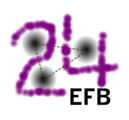Speaker
Description
Few-nucleon systems are the basic laboratories for studying the mechanisms of interactions between nucleons. In three-nucleon systems, at intermediate energy, below the pion production threshold, the effects of three-nucleon forces (3NF) are generally small and hard for experimental study. To take a step forward into larger system, a four-nucleon (4N) were studied, where sensitivity to the 3NF effects becomes higher.
Experiments devoted to studies of 3NF were carried out at the KVI in Groningen in the Netherlands. The BINA detector system collected a set of high precision data of the deuteron breakup reaction with the use of 160 MeV deuteron beam. The detector has been designed to detect charged reaction products, mainly protons and deuterons. A number of techniques have now been developed to allow direct registration of neutron. Using the time-of-flight method and signal asymmetry in the scintillators, we were able to reconstruct the neutron momentum from the collected data. Using this information, the new reaction channel $^2H(dn)p$ were measured. Having determine the differential cross-section for this reaction one can compare it with analyzed $^2H(dp)n$ channel [1, 2] at the same kinematic conditions and direct study the coulomb effect and possible charge symmetry breaking, like it was suggested in [3].
The results covering sample distributions of differential cross section of $^2H(dn)p$ reaction as well as important steps in neutron detection methods will be presented.
References
[1] I. Ciepał et al. Phys. Rev. C 99 (2019) 14620.
[2] G. Khatri et al., Acta Phys. Pol., B47 (2016) 411.
[3] C. R. Howell et al., Phys. Rev. C 48 (1993) 2855.
